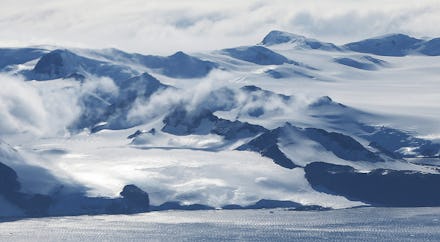Visiting Antarctica: How to travel to the world's most isolated continent

Antarctica is the most remote and inhospitable place on Earth. It is home to the coldest and windiest spots on the planet. Despite recent murmurs of an alleged "ancient Antarctic pyramid" — in reality, it's just a symmetrical mountain — Antarctica is the only continent that has never been inhabited by an indigenous people. It is the great white unknown at the bottom of the globe, which is precisely why it attracts the intrepid and adventurous.
"Antarctica has this mythic weight. It resides in the collective unconscious of so many people, and it makes this huge impact, just like outer space. It’s like going to the moon." – Jon Krakauer
If you are one of those people who longs to see the breathtaking glaciers and diverse wildlife of the frozen desert that is Antarctica, there are a handful of ways to do so. Here are some of the different methods for getting to Antarctica, depending on what type of adventure you long for.
How to get there
There are a few ways people secure travel to Antarctica. Scientists who visit can receive funding from the United States Antarctic Program to expand the base knowledge of the region and research Antarctic Earth systems. And writers or artists can get funding from the National Science Foundation to work on long-term projects that promote understanding and appreciation of Antarctica, with a dual motive of fostering support for scientific endeavors. There are also plumbers, carpenters, electricians and other specialists doing necessary jobs in the ice towns that house these scientists and artists.
But for those who don't have the special skills and training to secure funding to live in Antarctica, you can also visit as a traveler. Tens of thousands of visitors came to the Antarctic both by cruise and by "landing," as in, actually stepping foot in Antarctica, in the 2015 to 2016 season alone.
Visiting by plane
For the day-tripper who is a fan of panoramic vistas — and is also willing to spend more than a thousand dollars on a day-long plane ride — the best option to see is Antarctica is by flyover. You can leave from Australia and spend the afternoon gliding over the mountainous white abyss from the comfort and warmth of a chartered plane, while being served food and drinks. And then you can land back in Australia the same day, never even feeling the Antarctic cold.
A flyover is comfy, but for the travelers who want a touch more adventure, there are a variety of expeditions to be had. Some flights touch down on the icy continent, and from there, travelers go on guided climbs of Vinson Massif, the tallest peak on the continent, or on to South Pole expeditions, where you can spend a few hours hanging out at the geographical bottom of the Earth.
Visiting by sea
For those who long to be closer to the scenery and wildlife than you can get by looking out the window of a jet but also don’t want to suffer through the foreboding inland landscapes of the frozen desert, one option is to take an Antarctic cruise.
A cruise will get you up close and personal with the wildlife and the spectacular views of the continent without having to endure fierce inland weather and dangerous geography. Some cruises offer on-shore day excursions for travelers who want to put their boot prints in the snow, while others simply float by the coast for sightseeing that's unlike anything else on Earth.
When to go
Time of year is also crucial, and the best time to go to Antarctica depends on what the traveler wants to see and experience. Tourism in Antarctica is nonexistent from April to October, since this is the austral winter, with blisteringly cold temperatures and more than 20 hours a day of darkness.
November and December are considered late spring and early summer in Antarctica. The weather this time of year offers some of the best views of snow and ice-covered scenery. November is also the season of courtship for penguins and other seabirds, but you're less likely to see whales and other marine life.
December to February is the austral summer in the Antarctic. With up to 20 hours of sunlight a day, the coast comes to life with the penguin hatching season and new baby seals on full view.
Late February through March is the last leg of the tourism season in the Antarctic, and it's when temperatures start to really dip. The landings at this time are rocky and muddy, as much of the coastal ice has melted at this point in the season. You won’t see much wildlife at this time, besides whales, but the end of tourism season is the best time of year for whale sightings.
The white world down below
Antarctica is a mysterious and mystical place that has attracted explorers and adventurers for years — and it's only been seen by a fraction of a faction of people worldwide. While still dangerous and not to be underestimated, this remote place is becoming more and more accessible.
If you have the opportunity, and the funds, to see the icy world that is the Antarctic, it's worth it — especially since climate change and rising temperatures are having a dramatic impact on the world's most isolated continent.
About the Author: Bennett Slavsky has worked throughout Michigan as a freelance writer and has been featured in such publications as the Grand Haven Tribune and the Detroit Free Press. He has a background in sustainability and is now working on writing and digital marketing at Keteka.